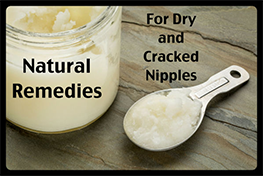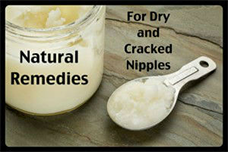
Red, itchy or sore nipples can be caused by any number of things. Many women who breastfeed, for example, experience nipple pain and irritation.
However, you don’t have to be a breastfeeding mother to have nipple discomfort, or even a woman for that matter. Friction from clothing (often called joggers nipple), eczema, allergic reaction to laundry detergent or certain fabrics or even hormonal changes can all cause dry or irritated nipples.
For whatever reason, irritated nipples are both painful and potentially embarrassing. Because nipples and the surrounding skin are very sensitive, it is important to treat this area with tender loving care.
While over-the-counter remedies may seem to do the trick – they often cause more irritation due to their composition and the addition of such things as fragrances or preservatives. Here are 3 natural ways to combat nipple discomfort.
Organic Raw Coconut Oil
Coconut oil is composed of medium chain fatty acids (MCT’s) which are not easily broken down or oxidized like polyunsaturated fat. This means that coconut oil does not cause any free radical damage, unlike polyunsaturated and dangerous trans fats.
The fact that most of our skin care products in this country are made from polyunsaturated oils explains why we, as a nation, suffer from so many skin complications. There is a great body of growing evidence to support the fact that topical application of coconut oil as well as consumption are highly beneficial.
Not only does regular consumption of coconut oil help to balance hormones, but when applied topically, it can bring great relief to sore, cracked, itchy nipples, even for those suffering from thrush. Its antifungal, antibacterial, anti inflammatory and antiviral properties make it not only a great skin softener but also a highly therapeutic treatment.
A study conducted in 2008 at the Skin and Cancer Foundation in the Philippines, compared virgin coconut oil and virgin olive oil in moisturizing dryness and removing bacteria from colonized Atopic dermatitis skin.
The study, a double-blind controlled trial, found that coconut oil was more effective than olive oil in killing bacteria, mostly because of its lauric acid content.
For breastfeeding moms, it is good to know that coconut oil is totally safe and very healthy for your baby as well. Apply a small amount of coconut oil to irritated nipples as often as needed.
Click here for 9 more reasons to use coconut oil every day!
Fresh Aloe Vera
The healing power of aloe vera has been embraced since ancient times. In traditional Indian medicine, it has a history of use for skin conditions and infections, among a plethora of other ailments, while in China, it is employed to combat fungal diseases. In the West, it is known that aloe vera cannot be beat to ease the pain of a nasty sunburn.
The leaf of the aloe vera plant is filled with a gel that contains over 75 nutrients, 20 different minerals including calcium, chromium, copper, iron, magnesium, manganese, potassium, phosphorus, sodium and zinc, 12 vitamins including A, B1, B2, B3, B5, B6, B12, C and E, 8 amino acids and 200 active enzymes.
Anecdotally, aloe vera is generally mentioned as being superior in its ability to help soothe burns or promote healing of cuts. A number of studies that have investigated these claims have found that aloe vera does, in fact, speed up wound recovery and also helps in the growth of new cells. Aloe vera also contains a powerful antibacterial component which helps to keep an infection at bay.
A recent report in the Journal of Dermatologic Surgery and Oncology reports that using aloe vera as part of post surgical treatment reduces recovery time. Eighteen patients who underwent facial dermabrasion surgery for acne were treated on one side of their face with standard surgical gel and dressing and on the other with aloe vera gel and dressing. The side that received the aloe gel healed 72 hours sooner than the side without; quite a testimony to the plant’s healing powers.
For sore and irritated nipples, simply apply fresh gel to the irritated skin as often as needed for relief. The cooling nature of this gel will bring immediate relief and the healing properties will begin their work on your skin.
A word of caution: Commercial aloe vera gels often include fillers such as maltodextrin (a corn sugar that likely comes from GMO corn), glycerin, glucose and malic acid, and sometimes an array of other chemicals that you probably do not want seeping into your skin.
Luckily, if you’ve got ample sunlight in your home, growing your own aloe vera is easy. Plant an existing aloe vera plant in a wide pot with well-draining soil. It should be watered generously, but allowed to dry to an inch or two deep between waterings.
You can also start an aloe vera plant from a cut leaf. Simply cut a leaf off of a mature plant, at least 3 inches long, and allow it to rest in a dry and warm location for several days to let it form a callus.
Once the callus forms, dip the cut end in rooting hormone and bury halfway in soil. Water regularly so the soil stays moist, being careful not to overwater, and in a few weeks, the leaf should grow roots.
To use, simply cut a leaf from a mature plant, squeeze out the gel, and smooth over skin.
Raw Apple Cider Vinegar
Traditional uses of ACV are vast. To name just a few, it has been used to ease digestion, aid in flu prevention, reduce inflammation, regulate pH balance, alleviate allergy symptoms, ease nausea and heartburn, as a staple in detox regimens, and for a number of skin conditions, including reducing acne, easing eczema and smoothing wrinkles.
Raw apple cider vinegar contains potent antifungal, antibacterial and antiviral properties, which help to make it so effective for so many conditions including eczema and thrush.
Relieve itching and irritation by mixing 1 cup of ACV in 5 cups of filtered water. Wash the affected areas with a clean cloth dipped in the mixture. This will help reduce swelling and will also help keep the infection from spreading.
A word of caution: Not all apple cider vinegar is created the same. Truly, the clear vinegar is of superior quality, right? It just looks better. Kind of like how the apple treated with synthetic chemicals and free of any bruises looks better than the organic apple that just fell from the tree and suffered a few bumps in the fall.
However, the truth is that the cloudy vinegar is, like the apple that fell from the tree, truly the best. The cloudy, somewhat nasty-looking vinegar actually contains beneficial living properties that lend to its therapeutic value.
 The natural fermentation of ACV has been done for hundreds, if not thousands, of years by numerous cultures. Crushed raw apples are placed in large wooden barrels and allowed to ferment naturally over time.
The natural fermentation of ACV has been done for hundreds, if not thousands, of years by numerous cultures. Crushed raw apples are placed in large wooden barrels and allowed to ferment naturally over time.
The resulting liquid is neither clear nor “perfect” looking. In fact, natural ACV should be brownish in color and contain what is known as the “mother.” This is the first thing you should look for when choosing quality apple cider vinegar.
For 81 more ways to use apple cider vinegar click here.
-The Alternative Daily
–

